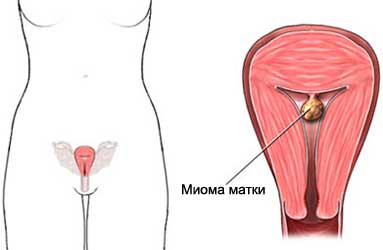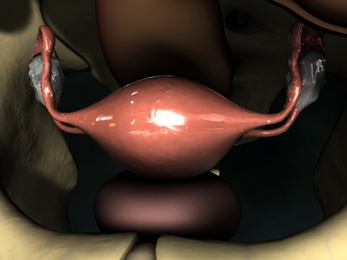Myomectomy – laparoscopic surgery – Removal of uterine fibroids
Description removal of uterine fibroids
Myomectomy involves removing fibroids from the wall of the uterus. Myoma is a benign tumor in the muscle of the uterus.

Reasons for removal of uterine fibroids
Myomectomy is performed to alleviate problems, caused by uterine fibroids without doing a hysterectomy (hysterectomies). These problems may include:
- Pelvic pain;
- Backache;
- Pressure on the bladder;
- Abnormal vaginal bleeding;
- The inability to get pregnant;
- Discomfort during intercourse;
Symptoms, induced uterine almost completely disappear after the procedure. Restores normal menstrual cycle and the ability to get pregnant.
Possible complications of removal of uterine fibroids
Complications are rare, but no procedure does not guarantee the absence of risk. If you plan to myomectomy, you need to know about possible complications, which may include:
- Bleeding;
- Surgical wound infection;
- Recurrence of fibroids;
- Damage to other organs;
- The wall of the uterus may be weakened, if a large fibroid is removed;
- Reaction to anesthesia;
- The need for special measures during pregnancy (eg, you must use cesarean section);
- Pelvic adhesions, which may cause pain and / or bowel blockage;
- Serious problems, detected during operation, necessitating hysterectomy;
- Severe scarring, resulting in infertility;
Factors, that may increase the risk of complications:
- Smoking;
- Alcohol abuse or drug use;
- Obesity;
- Chronic or recent illness;
- The use of some drugs;
- Diabetes.
How is the removal of uterine fibroids?
Preparation for the procedure
They may be assigned or conducted by Dr. following procedures:
- Medical checkup;
- Blood tests;
- Revision of drugs taken;
- Dilation and curettage of the uterus – Procedures for tissue removal endometrium (endometrial);
- Ultrasound – research and implementation of images of the pelvic organs;
- Intravenous pyelogram – X-rays of the kidneys, ureter and bladder after injection of contrast medium into a peripheral vein (held, If fibroids affect the ureters);
You should discuss with your doctor:
- The need for hormone replacement therapy 2-4 months before the procedure, to reduce fibroids. This reduces the risk of excessive blood loss during the procedure;
- If cancer is found in the uterus – One option is to remove the uterus during the myomectomy;
- Maybe you should hand over their pre-donated blood for the procedure.
In the run-up procedure:
- Consult your doctor about the drugs taken. A week before surgery you may be asked to stop taking some medicines:
- Aspirin or other anti-inflammatory drugs;
- Blood thinners, Taki how warfarin and clopidogrel;
- It is necessary to organize the delivery of home from the hospital. Besides, We need to organize care at home during recovery;
- Do not eat or drink for at least eight hours before the procedure.
Anesthesia
At step used general anesthesia. The drug is injected in the arm. During surgery, the patient is in sleep.
Procedure myomectomy
The doctor makes a small incision in the navel, through which it inserts a laparoscope into the abdominal cavity. A laparoscope is a tube with a tiny camera on the end. The doctor will use it, to examine the abdominal cavity. The abdomen will be made two or three additional small incisions, which are inserted through other small surgical instruments. The doctor finds and removes fibroids. In some cases, you may be given medication vasopressin, to reduce blood loss. After, as the fibroids removed, doctor sews up the incision.

Keep in mind, In some cases,, doctor, perhaps, You have to go to open surgery to remove fibroids. During open surgery, he will make a large incision in the abdomen, to carry out the operation.
Immediately after myomectomy
After the procedure:
- You will be directed to the recovery room;
- It will conduct monitoring on the presence of complications;
- Through the IV fluids and medications are administered.
How long will the removal of uterine fibroids?
1-2 o'clock.
Removal of uterine fibroids – Will it hurt?
Will feel abdominal pain and discomfort for 7-10 days. The doctor will give pain medicine, to reduce pain.
The average hospital stay
2-3 day.
Care after the removal of uterine fibroids
Full recovery takes about 4-6 weeks. When you return home, Follow these steps:, to ensure the normal recovery:
- Be sure to follow your doctor's instructions;
- Wear sanitary pads or napkins, to absorb the stand-blood. The first menstruation after the procedure may be more difficult to pass, than usual;
- Try to walk often. This will reduce the risk of blood clots;
- Take your medicines, as prescribed by your doctor. If you had to stop the medication before the procedure, ask your doctor, when you can renew it;
- Ask the doctor, when it is safe to shower, bathe, or to expose the surgical site to water;
- Ask your doctor, when you can:
- Back to work;
- Resume sexual activity;
- Resume sports (perhaps, will have to wait 2-6 weeks).
Contact your doctor after removal of uterine fibroids
After discharge from the hospital need to see a doctor, If the following symptoms:
- Signs of infection, including fever and chills;
- Redness, edema, strong pain, bleeding or discharge from the incision site;
- Excessive vaginal bleeding after the procedure;
- Excessive vaginal discharge, which lasted more than a month after the procedure;
- Vaginal discharge, with an unpleasant odor;
- Severe abdominal pain;
- Headache, muscle aches, dizziness, or general malaise;
- Nausea, vomiting, constipation, abdominal distention;
- Pain and / or swelling of one or both legs;
- Symptoms of fibroids occur again after the procedure;
- Cough, shortness of breath or chest pain;
- Pain, burning, frequent urination or persistent bleeding in the urine;
- New disease symptoms.
